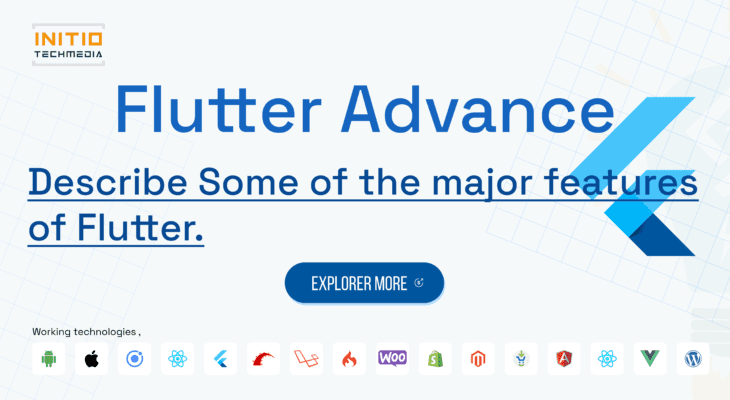Leading Mobile & web Development company which is providing Ready to publish apps & on demands application in Global Bussiness.
- 908, B Square 2, Ambli Rd, near Hotel Double tree Hilton, Vikram NagarAhmedabad-380054, Gujarat, India
- (+91) 8758432204Give us a call
- contact@initiotechmedia.com24/7 online support

Describe Some of the major features of Flutter.
- payal patel
- May 22, 2023
- 0
Flutter, developed by Google, is a cross-platform UI toolkit that allows developers to build high-performance native applications for mobile, web, and desktop from a single codebase. Here are some of the major features of Flutter:
Fast Development: Flutter enables rapid development with its hot reload feature, which allows developers to see the changes in real-time without restarting the app. This significantly speeds up the development cycle and helps in quickly iterating and refining the UI.
Single Codebase: Flutter follows a “write once, run anywhere” approach, meaning you can write a single codebase for both iOS and Android platforms. This saves development time and effort, as there’s no need to maintain separate codebases for different platforms.
Expressive UI: Flutter provides a rich set of pre-designed widgets that offer a wide range of UI elements and controls. These widgets can be customized and composed to create visually appealing and interactive user interfaces.
Native Performance: Flutter applications are compiled to native ARM code, allowing them to achieve near-native performance. The Flutter framework leverages Skia, a powerful 2D rendering engine, to provide smooth animations and performant graphics.
Hot Reload: With Flutter’s hot reload, developers can make changes to the code and see them reflected instantly in the running app. This feature dramatically improves the development workflow by reducing the time spent on rebuilding and redeploying the entire application.
Access to Native Features: Flutter provides access to a broad range of native device features and APIs through its extensive set of plugins. Developers can seamlessly integrate device-specific functionalities such as camera, location, sensors, and more into their Flutter applications.
Responsive Layouts: Flutter uses a flexible layout system that adapts to different screen sizes and orientations. It offers widgets like
Expanded,Flexible, andMediaQuerythat help in building responsive and adaptive UI layouts.Material Design and Cupertino Styles: Flutter supports both Material Design, the design language for Android, and Cupertino, the design language for iOS. This allows developers to create platform-specific UIs or build apps with a custom look and feel.
Flutter Widgets: Flutter provides a vast collection of customizable widgets, ranging from basic UI elements to complex layouts and animations. These widgets are designed to be composable, allowing developers to combine them to create complex UI structures.
Dart Programming Language: Flutter uses Dart as its programming language. Dart is a modern, object-oriented language with features like strong typing, asynchronous programming, and a rich set of libraries, making it easy for developers to build complex applications.
These are just a few of the major features that make Flutter a powerful framework for developing cross-platform applications. Its combination of fast development, high-performance UI, and excellent native integration makes it a popular choice among developers.
WhatsApp us

